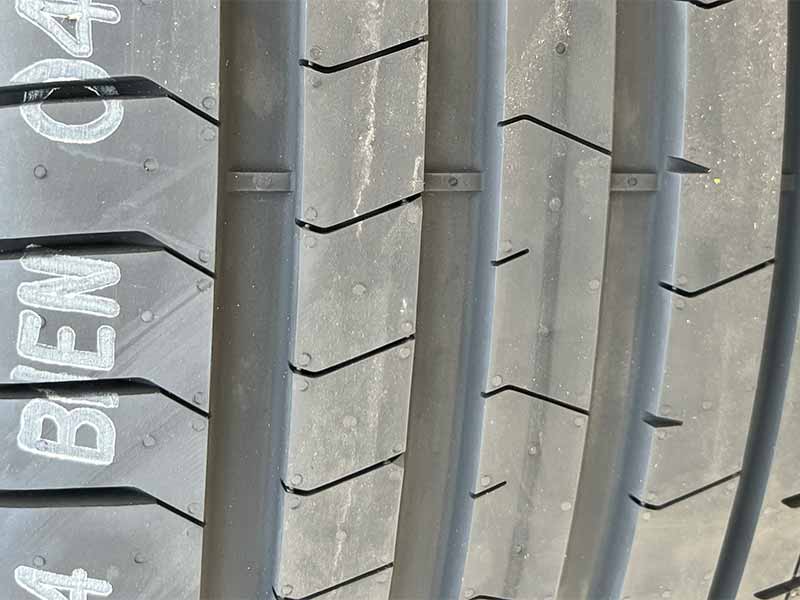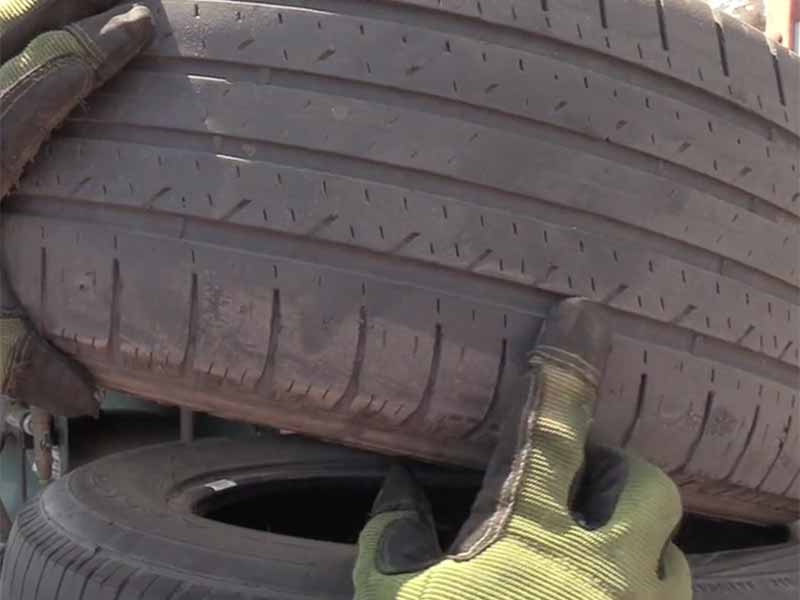Tires are critical to your safety, the safety of your family, and the other drivers on the road. Proper tire maintenance services are often ignored or not properly understood by many car and truck owners.
But tires are expensive and no one wants to pay for a tire replacement if it isn’t necessary. Understanding tread depth, tire maintenance tasks, and what uneven tire wear patterns mean are all helpful to keeping everyone safe and saving you money.
Tire Wear
Tire wear is measured in 1/32″ increments with 2/32″ remaining being the minimum tread depth and the depth of the wear bar indicators in your tread grooves.
Uneven tire wear patterns indicate problems with tire pressure, wheel alignment issues, or suspension system components that need to be replaced.
In this article, we’ll cover all you need to know about understanding tread wear.
Let’s take a closer look.
Tire Tread Depth
Tire wear depth isn’t complex, but it is important to understand that your tires slowly lose their ability to stay in contact with the road in adverse weather conditions as they wear down.
New Tire Tread Depth
New tires typically have around 10/32″ or 11/32″ of tread depth. While most tires have a similar amount of tread depth, this doesn’t mean that they will all last the same amount of miles.
Different tread designs and rubber compounds will wear at different rates. Most new tires come with a tread life warranty that guarantees a certain number of miles if you meet the requirements for properly maintaining them.
Minimum Tread Depth
The minimum depth is 2/32″. Once your tires have worn down to this depth you should stop using them and have them replaced immediately.
It is recommended that you replace your tires before they have become this worn. It’s best to replace them at 4/32″ or 3/32″. This is because there is very little depth left to move water out from underneath the contact patch.
Stopping distances on a wet road surface will dramatically increase as your tread becomes shorter. The chances of hydroplaning also dramatically increase as your tread wear reaches the lowest levels.
Wear Bars (Indicator)
Most passenger vehicle tires include wear bars in the grooves of your tire tread. These wear bars are used to make it easy to determine when your tires need to be replaced.
Once tire wear reaches the wear bar, it is time to replace your tires. The height of the wear bar is 2/32″ above the bottom of the tread grooves which is the minimum tread depth and the time you must replace your tires.

Bald Tires
Tires are considered bald once they reach 2/32″ or less of tread wear. This is the same height as the wear bar indicators. If the wear bars are flush with the top of the tread blocks and ribs you know that your tires are considered bald.
Winter Tire Minimum Tread Depth
The minimum tread wear depth for winter tires, or all-season tires that you’re actively using in snowy conditions, is between 5/32″ and 6/32″.
Snow and slush don’t flow like water and deeper tread grooves are required to get proper traction in these severe weather conditions.
How To Check Tire Tread
To accurately measure tread depth you will need a tread depth gauge. These are simple tools that you insert into a tread groove and they will measure the distance from the top of the tire surface to the bottom of the groove.
Plunger-Style Tread Depth Gauge Example
Alternatively, you can use a penny to check tread wear.
Penny Test For Tire Wear
The penny test is a convenient method for testing your tread wear depth. Insert a penny between the tread blocks and look at how much of Honest Abe’s head is protruding above the tread blocks.
Acceptable Tread Depth
If you can’t see the hair in front of President Lincoln’s forehead you have 4/32″ or more of tire tread wear left and you’re good to go for now.
Replace As Soon As Possible
If you can see some of his hair in front of his forehead you’re in the danger zone and you’ll need to replace your tires soon.
Replace Immediately
If you can see all of Lincoln’s head you know it’s time to replace your tires. Abe doesn’t lie. The top of his head is equivalent to 2/32″ of tire tread wear left.
Normal Tire Wear Pattern
Normal tire wear is described as wear that is even and consistent from sidewall to sidewall. This is a “somewhat” reasonable expectation for some cars and trucks, while others will never be able to achieve this due to the design of the vehicle or intended use.
For instance, you can expect heavy inner wear on the rear tires of most sports cars. This is because the suspension system is designed to maximize handling performance and traction over even tire wear. Negative camber helps improve traction in turns and stability.
No matter your situation, to get the most life and as normal a tire wear pattern as possible you should be sure to:
- Check Tire Pressure Regularly
- Perform Tire Rotation Every 5,000 Miles
- Perform Wheel Alignment Every 10,000 Miles
- Rebalance Your Tires Every 10,000 Miles
Uneven Tread Wear Patterns
Unusual wear patterns can be a headache for even those that are diligent about tire maintenance. Alignment problems and tire pressure are often the cause of most uneven tire wear patterns, but they aren’t the only cause.
Regular tire rotation can help minimize the effects of an uneven wear pattern but tire replacement may be required if the problem wasn’t caught in time.
Some common tire wear patterns that vehicle owners struggle with are described below:
Inner Wear
An inner wear pattern is usually a result of poor wheel alignment. Negative camber wear is common on the rear tires of sports cars. Front tires with inner wear are usually improper alignment of toe.
Outer Wear
Toe wear is usually the cause of outer edge wear. If negative toe alignment is too far in the outer edges of your front tires will have excessive wear.
Some suspension component damage and wear can also cause this type of wear on the edge of the tire.
Inner And Outer Wear
Inner and outer tire wear patterns are a classic result of under-inflated tires. When the air pressure is too low the tires ride on the inner and outer shoulders due to the air pressure not adequately supporting the vehicle. This causes the sidewalls to have to support the vehicle more and can quickly ruin your tires.
Center Wear
Center wear is a direct result of your tires being over-inflated. Too much air pressure causes the tires to balloon outward and due to the internal supporting structure of the tire, the center of the tire tread pushes outward.
The tire will have much more pressure on the road surface along the middle of the tread causing accelerated center wear.
Cupping
Cupped tires are those that have diagonal grooves across them from sidewall to sidewall. Sometimes the cupping wear in only on the inner or outer edge of the tire.
A cupping pattern is almost always a problem with your wheels. It could be that the tires and wheels are out of balance, or the wheels themselves are out of round due to damage from potholes or curb strikes.
Patchy Wear
A patch wear pattern is often the result of internal tire damage such as broken belts. It can also be the result of several different types of tire wear problems occurring at the same time.
If this is the tire wear pattern that you’re suffering with we highly recommend visiting your local tire shop and having a tire expert diagnose the problem.
Heel Toe Wear
Heel-toe wear is a sawtooth-like shape occurring to the tread blocks around the circumference of your tire.
If your tire wear is like this it is likely the result of poor toe alignment or aggressive driving style. It could also be a suspension system problem due to a component failure or excessive wear.
Tire Feathering
Feathering is easy to spot. It looks like feather-like ribbons of rubber hanging off one side of your tread blocks. The opposite side of the block will be rounded slightly.
This is often due to poor toe alignment or suspension system problems that are causing the alignment problem.
Learn More About Uneven Tire Wear
How Long Do Tires Last?
Typical all-season tires on fairly average sedans, hatchbacks, and smaller trucks and SUVs will frequently last 50,000 to 60,000 miles. This can vary quite a bit depending on the vehicle and tire brands.
Sports cars, for instance, will usually see much worse tire wear due to the more handling-focused suspension geometry design and tire designs that use softer rubber compounds.
Tire manufacturers will often provide a tire wear guarantee. If you meet the warranty requirements you can make a warranty claim and receive a discount based on the amount of unrealized tire life on a set of new tires.
UTQG Treadwear Rating
Uniform Tire Quality Grade is a standard developed by the U.S. government that attempts to provide some apples-to-apples comparison measurements for tire buyers.
One of these measurements is Treadwear. Each tire is compared to a reference tire. The reference tire score is 100, which is quite poor by today’s standards.
Treadwear ratings of 500 or greater are excellent. Sports car tires tend to have scores that are quite lower due to the softer compounds. It’s common for them to have a treadwear rating of around 300.
Resources
Below are some links you may find helpful when learning about tires
- The importance of tread depth – Continental Tires
- How to read tire wear patterns and improve your safety – Firestone
Final Thoughts
Tire wear patterns and depths are critical to your safety yet surprisingly not well understood or attended to by most vehicle owners.
Uneven tire wear patterns such as inner or outer edge wear can be extremely frustrating if you don’t understand what can cause them.
Be sure to check your tire pressure regularly and be sure it matches the air pressures listed in your driver’s door jamb or owner’s manual.
Rotate, balance, and align your wheels and tires regularly to keep your tire wear even and make them last as long as possible.
Hopefully, this article has you feeling much more confident about how to save time and money by keeping your tires in top condition.
Good luck and happy motoring.






